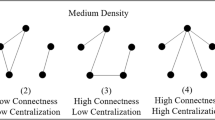Abstract
This study was performed at one site of a multi-site, multi-year interprofessional educational intervention. Objective Perform a pilot study to assess the ability of repeated Social Network Analyses to document a structural change from hierarchical to small-world networks in an educational intervention. Design we performed Social Network Analysis (SNA) of all interprofessional conferences each year looking for co-presentation (joint presentation by more than one speaker), especially when it involved more than one profession. We created NxN matrices, where N was the total number of speakers, which were coded by profession. Each matrix element was filled by the number of co-presentations between that faculty pair. The matrices were imported into Ucinet for quantitative analysis. We also graphed the social network maps of all speaker pairings. Subjects We included all listed speakers from the four core professions (medicine, pharmacy, nurse practitioner, psychology) for all conferences and grand rounds between 2013–2016. Main Measures For each year, we calculated the clustering coefficient, the small-world index, and Eigenvalue centrality for that year’s speakers. Key results over the four years of the study, clustering coefficients increased from 0.5 to 1.027, the small-world index increased from 3.149 to 31.39, and Eigenvalue centrality grew to include persons with large values (more importance) from each profession. Co-teaching events outside the program also increased and developed more relational structure (connectedness), suggesting an influence from the educational intervention on institutional norms of coteaching. The analytical results suggest a change from a physician-centric hierarchical to an egalitarian small-world social structure. Social network maps confirm this impression. This pilot study suggests that repeated Social Network Analysis may work well for documenting important structural changes as part of a program evaluation of interprofessional educational interventions.


 = physician;
= physician;  = nurse;
= nurse;  = nurse practitioner;
= nurse practitioner;  = pharmacist;
= pharmacist;
 = psychologist; Node size = Eigenvalue centrality (importance in the network); Tie thickness = number of co-teaching events
= psychologist; Node size = Eigenvalue centrality (importance in the network); Tie thickness = number of co-teaching events



Similar content being viewed by others
Data availability
This article contains data which will be provided upon reasonable request.
References
Borgatti SP, Everett MG, Freeman LC (2002) Ucinet for Windows: Software for Social Network Analysis. Harvard, MA
Chambers D, Wilson P, Thompson C, Harden M (2012) Social network analysis in healthcare settings: a systematic scoping review. PLoS ONE 7(8):e41911
Currie G, White L (2012) Inter-professional barriers and knowledge brokering in an organizational context: the case of healthcare. Org Stud 33(10):1333–1361. https://doi.org/10.1177/0170840612457617
Haddera W, Lingard L (2013) Are we all on the same page? Anal Interprofessional Collab Acad Med 88(10):1–7. https://doi.org/10.1097/ACM.0b013e3182a31893
Hall P (2005) Interprofessional teamwork: professional cultures as barriers. J Interprof Care. https://doi.org/10.1080/13561820500081745
Holtrop JS, Ruland S, Diaz S, Morrato EH, Jones E (2017) Using social network analysis to examine the effect of care management structure on chronic disease management communication within primary care. J Gen Intern Med 33(5):612–620
Huang Z, Wang Z, Zhang R (2019) Cascade2vec: learning dynamic cascade representation by recurrent graph neural networks. IEEE Access. https://doi.org/10.1109/ACCESS.2019.2942853
Jippes E, Steinert Y, Pols J, Achterkamp MC, van Engelen JML, Brand PLP (2013) How do social networks and faculty development courses affect clinical supervisors’ adoption of medical education innovation? an exploratory study. Acad Med 88:398–404
McChrystal S (2015) Team of Teams. Portfolio Penguin, UK
Merton RK (1968) Social Theory and Societal Structure. Rawat, India
Paradis E, Whitehead CR (2015) Louder than words: power and conflict in interprofessional education articles, 1954–2013. Med Educ 49:399–407. https://doi.org/10.1111/medu.12668
Phillips CB, Hall S, Irving M (2016) Impact of interprofessional education about psychological and medical comorbidities on practitioners’ knowledge and collaborative practice: mixed method evaluation of a national program. BMC Health Serv Res. https://doi.org/10.1186/s12913-016-1720-z
Sabot K et al (2017) Use of social network analysis methods to study professional advice and performance among healthcare providers: a systematic review. Syst Rev. https://doi.org/10.1186/s13643-017-0597-1
Smit LC et al (2021) Implementation of an interprofessional collaboration in practice program: A feasibility study using social network analysis. Pilot Feasibility Stud 7(1):7. https://doi.org/10.1186/s40814-020-00746-3
Song S, Chen X, Zhang G (2014) Structure of small world innovation network and learning performance. Math Probl Eng. https://doi.org/10.1155/2014/860216
Stabell CB, Fjelstad OD (1998) Configuring value for competitive advantage: on chains, shops, and networks. Strat Manage J 19:413–437
Stanton NA, Walker GH, Sorenson LJ (2012) It’s a small world after all: contrasting hierarchical and edge networks in a simulated intelligence analysis task. Ergonomics 55(3):265–281. https://doi.org/10.1080/00140139.2011.642006
Uddin S, Hamra J, Hossain L (2013) Mapping and modeling of physician cooperation network. Stat Med. https://doi.org/10.1002/sim.5770
VA Centers of Excellence for Primary Care Education, Request for Proposals. Available at: https://www.va.gov/OAA/docs/CoEPCE_Stage_1_RFP.pdf. Accessed August 29 2021.
Watts DJ, Strogatz SH (1998) Collective dynamics of ‘small-world’ networks. Nature 393(6684):440–442. https://doi.org/10.1038/30918
Yao N et al (2018) An exploratory study of networks constructed using access data from an electronic health record. J Interprof Care 32(6):666–673. https://doi.org/10.1080/13561820.2018.1496902
Zimmerman KA. What is Culture? https://www.livescience.com/21478-what-is-culture-definition-of-culture.html (2017). Accessed 25 April 2021.
Funding
The Coordinating Center, Centers of Excellence in Primary Care Education, VA Office of Academic Affiliations provided some protected time for all authors.
Author information
Authors and Affiliations
Contributions
The authors wish to thank the Coordinating Center, Centers of Excellence in Primary Care Education, VA Office of Academic Affiliations for their ongoing encouragement and financial support.
Corresponding author
Ethics declarations
Conflicts of interest
The authors have no conflict of interests or competing interests to report.
Additional information
Previous presentations: A version of this project was presented as a poster at the Northwest Regional Society of General Internal Medicine meeting in January 2020 in Portland, Oregon.
Rights and permissions
About this article
Cite this article
Smith, C.S., Fisher, A.K., King, I.C. et al. Pilot study of repeated social network analysis (SNA) to assess structural changes in an educational program evaluation. SN Soc Sci 3, 20 (2023). https://doi.org/10.1007/s43545-022-00592-5
Received:
Accepted:
Published:
DOI: https://doi.org/10.1007/s43545-022-00592-5




